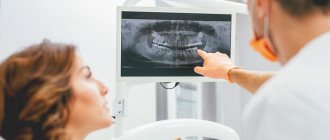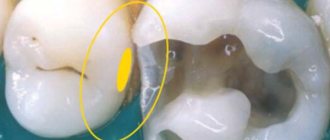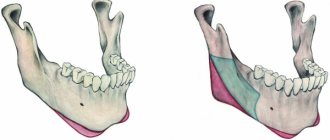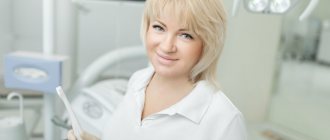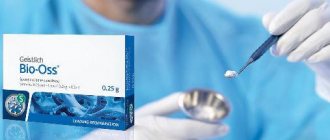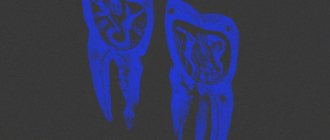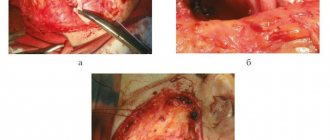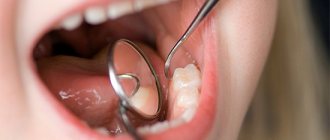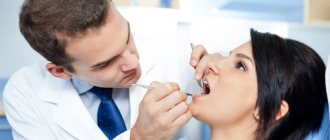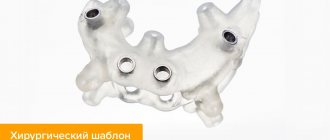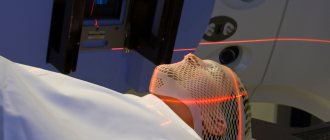Safety of X-ray diagnostics
The standard of safe radiation exposure is regulated by the federal law “On Radiation Safety of the Population”. Article 9 of this law “State regulation in the field of radiation safety” states that the average effective dose for the population per year is 0.001 sievert (1 millisievert). In this case, the dose received during one cone-beam computed tomography is 0.09 millisieverts. Accordingly, at least 10 CT scans of teeth can be safely performed per year.
For comparison, during air travel the radiation dose is on average 0.08 millisieverts. The dose of so-called natural radiation is 2.4 mSv. It consists of the effects of cosmic and solar rays, the influence of atmospheric radioactive atoms (radon), radiation from soil and building materials, and food radionuclides. Thus, performing a dental CT scan is absolutely safe for your health.
Advantages
CBCT has a number of advantages over other diagnostic methods:
- Quick examination of the pathological area. A single rotation of the frame reduces the radiation dose by up to 15 times. Radiation exposure – up to 50 µSv.
- Scanning step – 0.125 mm.
- There are no prerequisites for the patient's position.
- The design is mobile and open.
- Creation of a layer-by-layer 3D model.
- A single planar sensor is used to increase image resolution. For comparison, with spiral CT there are a thousand point detectors.
- The image quality is 5 times higher than in MSCT.
- The 3D model is used to obtain a sample for implantation. A copy is created on a 3D printer.
- Special software that allows you to select the angle and scanning mode.
The procedure for performing CT scans of teeth in Moscow at Dental Guru clinics
Computed tomography of the jaw, Moscow. Any Dental Guru clinic has a full range of X-ray diagnostics, including a computer tomography machine. No special preparation required. Before the examination, all metal jewelry and items of clothing (earrings, chains, piercings in the dentofacial area, hairpins) are removed. A lead vest or apron is worn to protect against X-ray radiation. To fix the head, the chin rests on the stand and the forehead on the bracket. During the examination, the sensor scans the dentofacial area. At this time, you should refrain from any movements, including swallowing. The patient sits or stands and the examination takes 30 seconds. At Dental Guru clinics, cone beam computed tomography is performed using a multifunctional Rayscan device.
The essence of the procedure
During cone beam tomography, the machine moves around the head. On one side, the device is equipped with an X-ray source, on the other, with an X-ray receiver. The receiver processes the received data.
The tomograph is connected to a computer, where a special program creates a 3D image of the jaw. As a result of the study, the tomograph takes many pictures - on average 500. This allows the doctor to see a specific area of interest from different angles and projections.
Thanks to high accuracy and computer processing, the image provides the specialist with the most reliable and complete information about the condition of the tissues.
Implant planning using CT
A CBCT scan is necessary before dental implantation. Three-dimensional examination reduces the risk of the procedure, significantly improves the quality of implant installation, and shortens the patient’s rehabilitation period. CT scan shows the condition of the bone tissue, possible inflammatory processes, the location of the maxillary sinuses, nerves and blood vessels, helps to create a model of the implant, calculate the depth of its immersion in the bone and the angle of inclination, and the optimal physiological load on the implant.
Why is 3D examination important before implant placement? An artificial root will stand long and firmly if it is surrounded on all sides by bone tissue. And here an individual approach is needed. The structure of bone tissue varies in shape, width, height, density, and possible defects. For longevity, it is important to choose a site where bone volume and density are sufficient. You need to choose the angle of inclination for acceptable aesthetics. In order to determine the required installation depth, you need to know the location of the nerves and blood vessels. Thus, it is possible to obtain a surgical navigation template for implantation for the most accurate virtual planning.
Types of modern CBCT machines
Modern dental tomographs differ in scan volume (field of view or FOV), the presence of a cephalostat and patient positioning.
Field of View (FOV)
CBCT machines are classified by field of view or scanning height as follows:
- For a localized area (dentoalveolar complex): about 5 cm
- For one jaw, upper or lower: 5-10 cm
- For both jaws: 7-10 cm
- For the maxillofacial area: 10-15 cm
- For the craniofacial region: more than 15 cm
Field of view (FOV) is one of the most important parameters of a CBCT scan and depends on the size and shape of the detector, as well as the features of the collimator (a device that blocks X-rays that do not pass through the area of interest).
The larger the maximum field of view, the higher the installation cost will be. For this reason, before purchasing a device, you need to decide what shooting modes you will need so as not to overpay for equipment. For example, for implantology, an FOV of 8×8 (in some cases – 10×10) is sufficient; for otolaryngology and maxillofacial surgery – from 10×15. For devices with modular architecture, the choice of FOV can be expanded in the future.
Equipment with cephalostat
The cephalostat is a separate “arm” of the dental tomograph. It is used by orthodontists to create teleroentgenograms—images of frontal and lateral projections of the skull. The photographs allow you to study the position of the jaws relative to the skull and each other, as well as the inclination of the teeth and are mandatory when planning the installation of braces.
There are the following models on the market: with cephalostat in the basic configuration, with the possibility of retrofitting, and without the possibility of retrofitting.
Clinics where an orthodontist works require a device with a cephalostat. If orthodontic services are not provided, but are planned in the future, the medical center requires a dental tomograph with the ability to retrofit with a cephalostat.
Patient position
There are three different types of CBCT platforms, depending on the patient's position:
- Sitting position
- Standing position
- Patient supine position
Devices that scan the patient while standing are more suitable for wheelchairs and take up no more space than orthopantomographs. Sitting units are considered more comfortable, but they take up more space and make the examination of patients with disabilities more difficult. CBCT devices with the patient in the supine position occupy the largest area and volume and are not adapted for examining all patients with physical disabilities.
Performing a CT scan with a radiopaque tray when planning a surgical template
Most patients who come for implants already have fillings, crowns, veneers or other dental restorations. All these materials can produce additional glare during CT scanning, so-called artifacts. To minimize them and ensure the accuracy of the CT examination, this procedure is performed using special radiopaque trays. They can be standard (if there are supporting teeth) or individual (when there are very few or no teeth and guidelines are needed for further work).
In these cases, special radiopaque trays are placed in the oral cavity, a CBCT (cone beam computed tomography of the jaws) is performed, then the trays are removed and sent to a dental laboratory. It is thanks to this type of research that it is possible to achieve accurate results and guarantee that the implant is installed in the area in which its location will be best. If implantation using surgical templates is planned, a CT scan with a radiopaque tray must be done. Before implantation with immediate loading, this study allows the fabrication of a temporary prosthesis to be worn before surgery.
If you do not do a CT scan before implantation, there may be:
- Loss of sensitivity and pain in the teeth and jaw.
- Injury to the gums due to incorrect calculation of the permissible load.
- Bite defects.
- Loosening and loss of the implant.
- Increased costs to correct problems, including installing a new structure.
This cannot happen in Dental Guru clinics. We care about the interests of our patients. All clinic specialists have extensive experience and high qualifications, confirmed by diplomas and certificates. CT scans of the upper and lower jaw are equally important.
Computed tomography of the upper jaw
To diagnose the condition of the maxillary sinuses before implantation, it is important to do a CT scan of the upper jaw. After tooth extraction, thickening of the mucous membrane in the maxillary sinuses often occurs; there may also be manifestations of sinusitis, a tumor process, the presence of a cyst or polyp. A CT scan of the jaw will show whether there is perforation of the maxillary sinus due to the protrusion of the root or crown of the tooth. The term “odontogenic sinusitis” means that the cause of the disease is in the tooth. The bony septum between the oral cavity and the maxillary sinus is quite thin, so infection from dental tissue can cause sinusitis. Therefore, for implantation to be successful, it is necessary to promptly identify and treat possible diseases and eliminate the inflammatory process.
Computed tomography of the lower jaw
A CT scan of the lower jaw, as well as the upper jaw, shows the condition of the teeth and bone tissue: possible diseases, inflammatory processes, granulomas and cysts. A CT scan of the jaw is important to identify hidden processes and timely initiation of treatment. A CT scan of the upper and lower jaw is usually done at the same time, but some clinics can do a CT scan of the upper and lower jaw teeth separately. The lower jaw bears the main load when chewing and speaking; chronic subluxation of the lower jaw is quite common. CBCT of the temporomandibular joint helps to make a diagnosis and distinguish subluxation from dislocation and fracture.
Types and results of examination
CT is recognized as an indispensable diagnostic tool in the treatment of pathologies in various segments of dentistry:
- In therapy - diagnostics of soft tissues surrounding the teeth, examination of passages, determination of the degree of root defect and treatment results.
- In surgery - identifying the source of inflammation, determining its size and location for bone collection for implantation. The doctor determines the presence of tooth remains after extraction and other surgical procedures.
- Orthopedics – objective assessment of supporting structures and ancillary units. The doctor can localize complications and select a treatment plan.
- Orthodontics – determination of circumstances that impede the quality installation of the structure.
There are a number of restrictions on CT scanning:
- Pregnancy and lactation.
- Mental disorders.
- Kidney failure.
- The patient's inability to remain still during the procedure.
- Lack of vital necessity for children under five years of age.
During the procedure, the patient must independently hold his head still.
CBCT is recommended if:
- Injuries and mechanical damage to teeth and jaws.
- Carious cavities hidden from other examination methods.
- Pathologies in the development and location of dental units.
- Indications for implantation and surgical interventions.
- Disorders of the maxillary sinuses.
- Complications after intracanal treatment.
It is advisable to use a diagnostic method to determine further tactics of dental treatment and its results.
Diagnosis of pathology of tissues surrounding teeth
In the presence of pathological changes in the periapical tissues, LCCT allows one to accurately diagnose the site of inflammation and identify a foreign body.
The examination is performed to detect cortical abnormalities and visualize the lingual and labial side.
Traumatic tooth decay
The doctor receives a 3D model when examining mechanical injuries:
- local defect or complete destruction of the root;
- mobility of units due to injury (luxation);
- tooth shortening;
- fracture of the alveolar process of the upper dental jaw.
The device is not capable of detecting root fractures in horizontal and vertical planes.
Dental examination of root damage
Root damage can be internal or external. External defects are diagnosed visually. Destruction of the unit from the inside is revealed by CT scan. The equipment builds a three-dimensional picture with changes in the transparency of the bone material.
CT algorithm
There is a method for a step-by-step description of targeted and panoramic dental 3D CT obtained as a result of the study. The detailed development of the algorithm provided dentists with the practical opportunity to study the image in depth and consistently.
Step-by-step algorithm for CT scanning:
- Study of a radiograph taking into account sharpness, distortion, contrast, and capture width.
- Assessment of bone tissue structure:
- condition of interdental septa;
- degree of change in the intraosseous structure;
- identification of impacted units;
- temporomandibular joint;
- paranasal and maxillary sinuses;
- mandibular canal.
- Determining the feasibility of additional diagnostic measures: targeted, extraoral radiographs.
- Study of dental units:
- identification of caries, fillings and their integrity;
- condition of roots;
- examination of root passages;
- periodontal fissure;
- examination of permanent orthodontic and orthopedic devices.
- Diagnosis of pathologies. The dentist evaluates the pathologically changed areas, their dimensions, location and nature.
Panoramic photo, CT scan of teeth in Moscow, price
For a CT scan of the jaw, the price in Moscow starts from 3,500 rubles. If you search online for “computed tomography of teeth price Moscow” or “computed tomography of jaw price”, then the average price of this examination in the search will be approximately 4,500 rubles. Dental Guru is currently running a unique promotion - a dental CT scan costs only 1,900 rubles. If the question of where to get a CT scan of a tooth is relevant to you, come to Dental Guru. When referred by a doctor, we guarantee non-interference in the patient’s treatment.
The doctor may also order two-dimensional examinations, such as spot and/or panoramic images. The targeted photograph shows the condition of 3-4 adjacent teeth. An OPTG (orthopantomogram) shows the condition of both jaws, including soft and hard tissues, malocclusions, impacted teeth and tumors, but you need to remember that this is a two-dimensional (single-view) image.
Indications
CT is recommended for use in the following situations:
- identification, precise determination of the position and extent of injuries;
- detection of inflammation, caries;
- study of structure;
- assessment of malocclusions;
- search for formations, cysts, tumors;
- checking for impacted units;
- diagnostics, assessment of the condition before prosthetics, installation of implants;
- preparation before surgical treatment, installation of orthodontic appliances.
Features of the procedure
The diagnostic process using computed tomography includes the following steps:
- Before the procedure, the Patient must remove metal and other jewelry to prevent malfunctions and distortions;
- to protect and reduce the degree of exposure, it is necessary to wear a special vest, all strangers leave the room with the equipment;
- the chin is fixed on a special stand; you cannot move or talk during the examination;
- After switching on, the scanner begins to move around the head, transmitting the resulting three-dimensional image to the computer.
The procedure takes no more than a minute, and the Patient does not feel pain or discomfort. No extensive preparation or anesthesia is required, and images can be taken immediately after the examination is completed.
Contraindications, how often can it be done
The examination has virtually no contraindications, but it is not recommended during pregnancy. Contraindications also include the period during breastfeeding; the procedure is not performed for small children. If a contrast scan is required, you should first check whether the Patient has any allergic reactions to the substances used.
The examination does not pose any danger, but it is recommended to do it no more than 12-14 times a year. Radiation exposure is minimal, for example, with standard fluorography the danger is much higher.
Evaluation of the results obtained
After performing the diagnostics, the Patient receives the results recorded on a flash drive or disk. Additionally, you can print the images or get a transcript if necessary. When assessing, the specialist takes into account the following aspects:
- condition of tissues, internal structure, jaw;
- assessment of the condition of canals and roots;
- occlusion anomalies, possible defects;
- tumors;
- retinalization of individual units.
With the help of CT, you can get the most complete picture, which is necessary for making a full, accurate diagnosis and choosing a treatment regimen.
Prices
The diagnostic procedure using CT costs from 1,500 to 500 rubles. The cost depends on the center where the services are provided and the diagnostic option:
- a photograph of a section of three teeth – 1,500 rubles or more;
- jaw – 2500;
- both rows (one side only) – 3500;
- full panorama – 4000;
- paranasal sinuses – 3000;
- full examination – 5000.
Additionally, you may be charged for recording data on a disk or flash drive, or for printing individual or several images. Therefore, if research is necessary, it is recommended to check with your doctor which images will be taken and for what purposes.
Commentary by the chief physician of the Dental Guru clinics
To understand the clinical picture, it is necessary to make an accurate diagnosis. Dental Guru dental clinics have all the necessary diagnostic equipment for x-ray diagnostics. These are multifunctional devices with the ability to take pictures of the temporomandibular joint, cephalometry, and a digital radiovisiograph for targeted imaging. We take a panoramic photo of the teeth, CT scan of the upper and lower jaw, the price is now unprecedentedly low. We are always glad to see you in our clinics. Call and make an appointment with specialists!
